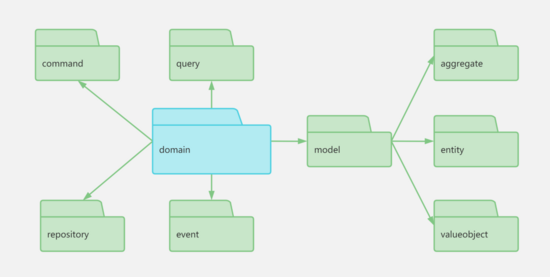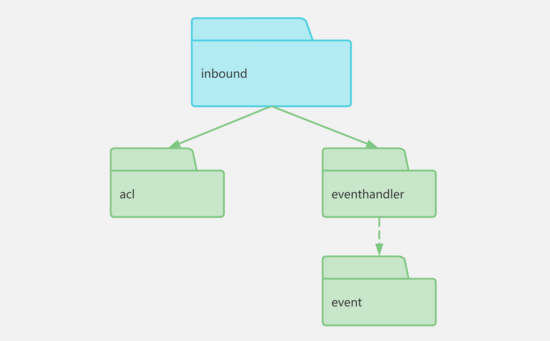Write it at the front :
Today, I'm going to talk to you ,DDD Complicated concept , How to design code implementation model in practice . Maybe you just read about this part , It is necessary for me to say more , About this topic , On the frame , It is divided into two parts : Methods + Practice chapter .
The former part , Methods . To introduce in detail DDD Contains several core concepts , And around these concepts DDD Code implementation model composition structure . As for why it is necessary to say , I made it clear at the beginning of the last article that .
in addition , Considering that some friends may just click in , I haven't read the last one yet , Or did not have time to see , So here is another point I would like to share the necessity of this topic , So as to help you quickly know what you can gain more or less .
To the point , It is a pity , At present, the industry is concerned about how to implement these concepts , There is no uniform set of standards and specifications , This leads us to the specific development process , Often feel unable to start .
So , This article has specially refined a complete set of DDD Code implementation model .
Besides , About the way you look , Let me say one more thing . It is updated and released in two parts , This involves succession . If you haven't read the last one , friend , I suggest you spend a few minutes first , Or combine the ideas of big and small titles in the article to guide , Have a general understanding of the following text framework . We can finish the last article , Then enter the sharing of this article , Combined with , better .
01 How to design DDD Code implementation model ?
Based on the analysis of DDD When the code implements the model , For the four components mentioned in the previous article , We need to sort out their code structures and dependencies . For code structure , We need to define the composition of the code package , As well as the technical components included internally .
After defining the package structure , Dependency means that we need to further clarify the interaction between these code packages and technical components . Based on these two points , Let's first discuss the code implementation model of domain objects .
︎ Domain object code implementation model
For domain objects , We usually use “domain” The word , Name the top-level package of the code package structure , All technical components under the package structure , Both belong to the category of domain objects .
To be specific , stay DDD in , Domain objects include domain model objects 、 Field events 、 The commands and query objects involved in the resource library and application services , Domain model objects can be divided into aggregations 、 Entity and value objects .
therefore , stay DDD All code implementation models , Domain objects involve the most complex code structures , It can be divided into two levels , Pictured 1 Shown .

edit
Add picture comments , No more than 140 word ( Optional )
chart 1
You can see , there “domain” Represents the entire domain object , and “model” Represents the domain model object , Note the difference in naming between the two , And their affiliation . Domain objects are DDD The foundation of the code implementation model , Contains the implementation of the core business logic .
︎ Application service code implementation model
Similarly , For application services , We usually use “application” To name the top-level package structure . Application services include query services and command services , So in the name of the sub package , Can also use “commandservice” and “queryservice” Distinguish , Pictured 2 Shown .

edit
Add picture comments , No more than 140 word ( Optional )
chart 2
obviously , Command service and query service , It depends on the domain object code to implement the command object and query object in the model , We use dashed lines to represent this layer of dependency . stay DDD Code implementation model , Application service is a code model with the most complex interaction relationship .
One side , It needs to combine command and query operations , Assign to domain model objects such as aggregate objects .
On the other hand , It also requires separation and infrastructure , And other gauge contexts .
About the latter , When we discuss the case study , There will be further development .
︎ Infrastructure code implementation model
Actually , So called infrastructure , refer to DDD Specific technologies used in the application 、 Tools and frameworks . Common infrastructure components mainly include these aspects :
therefore , The package structure of the infrastructure is not fixed , But flexible organization according to specific technical development requirements , Here is a common package structure , Pictured 3 Shown . For infrastructure , We used “infrastructure”, Name the package structure .

edit
Add picture comments , No more than 140 word ( Optional )
chart 3
There is one thing to note in the above figure , On behalf of data persistence “persistence” package , Communicating with a representative message “messaging” package , It is the most common in the infrastructure code implementation model , Because they correspond to the resource library and domain events in the domain object respectively .
stay DDD in , The definitions of the repository and domain events are located in the domain object code implementation model , They have nothing to do with the specific implementation technology . Persistence and message communication related to specific implementation technologies , In the infrastructure code implementation model . This reflects the design principle that domain objects and implementation technologies are separated from each other .
︎ Context integration code implementation model
Last , Let's discuss the context integration code implementation model . It should be noted that , This model is the most difficult to implement , Because it involves a variety of system integration technology systems .
Implement the model for this code , We first need to make it clear that it is oriented to multiple bounded contexts , So we need to consider the flow of data , That is the so-called introversion (Inbound) Data and extroversion (Outbound) data .
One side , Bound context , Access portals need to be exposed for use by other contexts . From the perspective of the current context , This is a Inbound operation . When a context makes a request to an external context , So that's one Outbound operation , Pictured 4 Shown .

edit
Add picture comments , No more than 140 word ( Optional )
chart 4
In the design of code implementation model , We will also use “inbound” and “outbound” To name the package structure . So under these two package structures , What technical components should be included ?
Let's talk about “outbound” Package structure , Pictured 5 Shown . In the figure ,“rest” In bag REST API Make an external request , Into internal Command and Query object , And hand it over to the application service for processing . In this transformation process , It is often necessary to introduce specialized DTO(Data Transfer Object, Data transmission object ) object , And assembler (Assembler) object .

edit
Add picture comments , No more than 140 word ( Optional )
chart 5
meanwhile ,“eventpublisher” Event publishers in packages (Event Publisher), Is used to publish domain events facing the external bound context .
next , We discuss “inbound” Package structure . In a gauge context , Data Inbound There are two main types of operations , One is anticorrosive coating (Anti-Corruption Layer,ACL), Used to send messages to remote REST API Initiate the request and get the result . The other is the event handler used to respond to domain events (Event Handler), Pictured 6 Shown .

edit
Add picture comments , No more than 140 word ( Optional )
chart 6
Context based integration process , In both contexts “inbound” and “outbound” The technical components contained in the package structure , In fact, it is one-to-one correspondence , Pictured 7 Shown .
You can see , A bounded context “inbound” Medium “acl” and “eventhandler”, Each corresponds to another bounding context “outbound” Medium “rest” and “eventpublisher”.

edit
Add picture comments , No more than 140 word ( Optional )
chart 7
thus , About DDD Four types of code implementation models in , Have introduced . In the following content , We will be based on a specific application scenario , Through case study , Put these code implementation models into practice . Based on this case , You can take all of the content introduced earlier in this article , And the daily development process , Further master the implementation methods and skills of converting the model into specific code .
02 DDD Code implementation model case analysis
In the real world , Work order processing is a very common business requirement . The initiation of work orders , It is usually because the user needs to consult or complain about the order .
In this scenario , be based on DDD The design method of , We can split the work orders separately (Ticket)、 Customer service (Staff), And the order (Order) These three bounds context . In these three contexts ,Ticket Context , Will be separated from Staff and Order These two contexts are integrated , To create a work order application , Pictured 8 Shown .
Please note that , The picture shows Ticket Context , Two different ways of context integration .
in the light of Staff Context ,Ticket The context will use REST API, Complete the acquisition of customer service data in the work order .
And for the Order Context , Domain events are used , That is, once Order The state of ,Order The context will send the corresponding domain event to Ticket In the context of .

edit
Add picture comments , No more than 140 word ( Optional )
chart 8
︎ Ticket Example of context code implementation model
obviously , For this scenario ,Ticket The context also has Inbound and Outbound operation . therefore , Its code implementation model is the most complete , Pictured 9 Shown .

edit
Add picture comments , No more than 140 word ( Optional )
chart 9
Above picture , We use IDEA This development tool and Spring Boot This particular development framework , To build the Ticket Code implementation model of bounded context . We can see clearly ,DDD Four code implementation models , There are five top-level code package structures . among , The context integration code implementation model also includes “inbound” and “outbound” These two code packages .
We will expand these top-level code package structures , You can get the picture 10 The sub code package structure shown in .

edit
Add picture comments , No more than 140 word ( Optional )
chart 10( Slide up and down to see )
All the sub code package structures shown in the figure above , The corresponding descriptions have been given in the previous contents , I won't repeat it here .
Ticket In the context of , Command service TicketCommandService Completed the Staff Context integration of services , At this time, the anti-corrosion coating is used ACL Components , The sample code is as follows .
You can see , Use here AclStaffService This ACL Components , Yes Staff The service initiated a remote call , Then fill the returned results into the command object , And create Ticket polymerization . Final , We go through TicketRepository Completed the persistence operation of the aggregate object .

edit
Add picture comments , No more than 140 word ( Optional )
chart 11
Above AclStaffService, It's done right Staff The context provides REST API Call to , The sample code is as follows . It's used here Spring Self contained RestTemplate Template tool class , Complete remote HTTP Endpoint access operations .

edit
Add picture comments , No more than 140 word ( Optional )
chart 12
︎ Staff Example of context code implementation model
stay Staff Context , We need to complete the above REST API The construction of , Its code engineering structure is shown in the following figure .
You can see , Comparison Ticket Context ,Staff The code structure of the context is relatively simple , Because the context only needs to provide external “outbound” package , The infrastructure only needs to complete the persistence of domain objects .

edit
Add picture comments , No more than 140 word ( Optional )
chart 13
︎ Order Example of context code implementation model
Last , We are here Order Bound context , Its code implementation model is like this , Let's have a look .

edit
Add picture comments , No more than 140 word ( Optional )
chart 14
We know Order Context , For Order Domain event publishing mechanism of data , So it's “outbound” The package contains... For publishing domain events “eventpublisher” subpackage , And provides a OrderEventPublisherService, As shown below .

edit
Add picture comments , No more than 140 word ( Optional )
chart 15
Through here Spring Cloud Stream, Realize the release of domain events . And in the Ticket In the context of , We can also be based on Spring Cloud Stream, Realize the monitoring and consumption of events in this field , The sample code is as follows .

edit
Add picture comments , No more than 140 word ( Optional )
chart 16
Please note that , Above OrderUpdatedEventHandler, be located Ticket Context “inbound” Bag ”eventhandler” In subpackage .
The explanation of these specific implementation codes is not the focus of this article , You can refer to the author in Github The case code on :https://github.com/tianminzheng/customer-service.
03 Summarize and extend thinking
That's the end of today's sharing . This article answers the questions of developers in detail , In the realization of DDD A core problem encountered in applications , That is, how to build DDD Code implementation model . The reason to discuss this topic , The reason lies in DDD Many of the concepts in are rather obscure , And the industry has no idea how to implement these concepts , Provide unified development specifications and standards .
And through the DDD Various complex concepts in are mapped with specific code implementation models , While helping us better understand these concepts , They can also be directly applied to the daily development process .
Through the introduction of this article , Developers can combine their own business development needs , Design a complete set of DDD Code implementation model . Here is also attached the full-text mind map , Help you review 、 Sort out ideas, etc .

edit
Add picture comments , No more than 140 word ( Optional )
chart 17 Full text thinking framework map - Help you quickly review 、 carding 、 summary
︎ Last , I think it is necessary to emphasize one point
The DDD Code implementation model , It is just a reference model . The design of code implementation model , It is also related to the technical system adopted . In the case shown in this article , We used Spring Boot、Spring Cloud Stream etc. Spring The development framework in the family , To develop DDD Applications .
And if you use Axon This is based on the event traceability model DDD Development framework , So in the code implementation model , You need to introduce a for event distribution and storage Gateway、EventStore And so on , The traditional data persistence components located in the infrastructure , May not necessarily be used .
Of course , Based on what we introduced today , It's not hard for you to do this DDD Code implementation model to extend .DDD As a system modeling methodology , There are also things like layered architecture 、 Clean architecture 、 Hexagonal architecture and other architectural styles .
For each architectural style , We all need to design the corresponding code implementation model .
Based on the content introduced in this article , Through to DDD The core concepts and implementation models in the , In this paper, I provide a systematic method to design code implementation model , To help you cope with the implementation requirements of different architectural styles .
This is also the core value of this article .
原网站版权声明
本文为[InfoQ]所创,转载请带上原文链接,感谢
https://yzsam.com/2022/176/202206251545459157.html


























